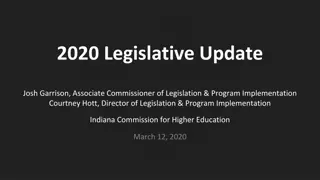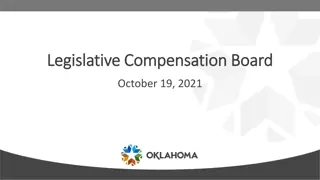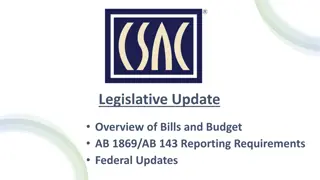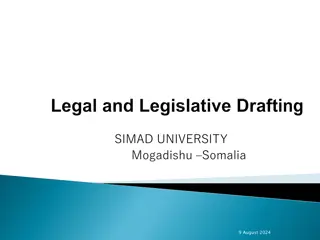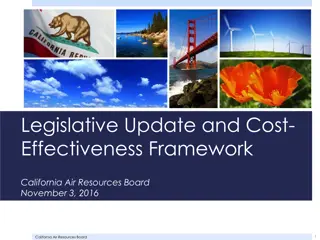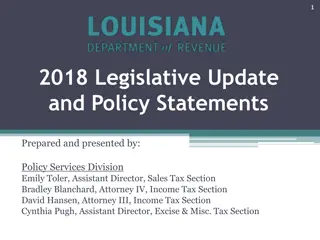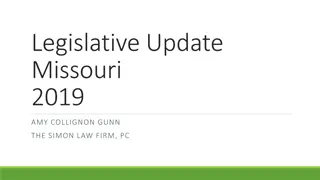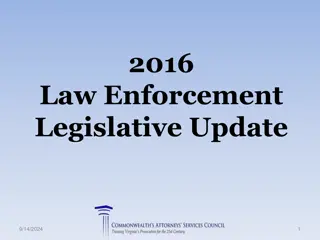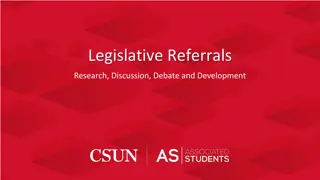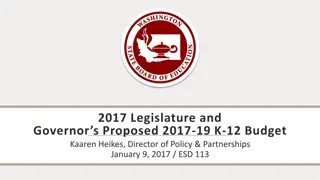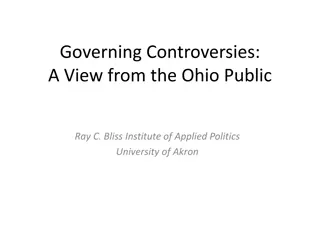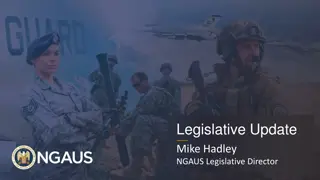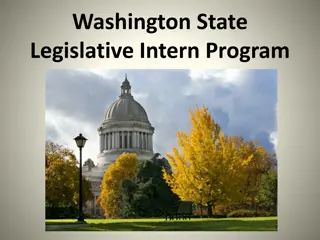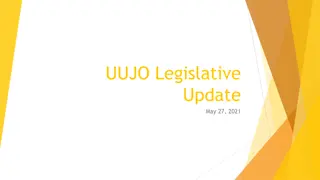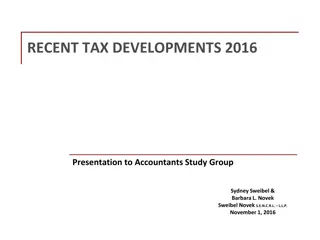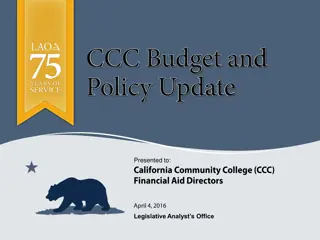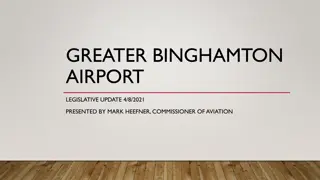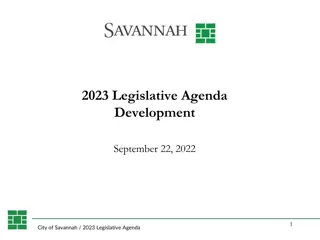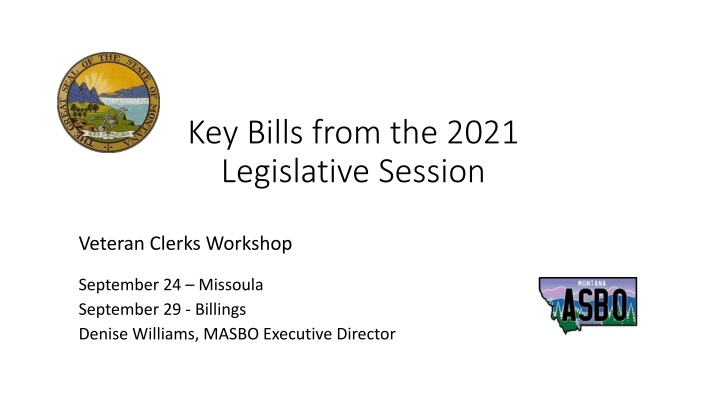
Key Bills from 2021 Legislative Session Impacting Teacher Pay
Discover key bills from the 2021 legislative session focusing on increasing starting teacher pay, including HB143 providing incentives, HB192 for school maintenance funding, HB233 for students with disabilities, and more. Learn about the legislative goals, effective dates, and requirements for teacher base pay to support educators.
Uploaded on | 0 Views
Download Presentation

Please find below an Image/Link to download the presentation.
The content on the website is provided AS IS for your information and personal use only. It may not be sold, licensed, or shared on other websites without obtaining consent from the author. If you encounter any issues during the download, it is possible that the publisher has removed the file from their server.
You are allowed to download the files provided on this website for personal or commercial use, subject to the condition that they are used lawfully. All files are the property of their respective owners.
The content on the website is provided AS IS for your information and personal use only. It may not be sold, licensed, or shared on other websites without obtaining consent from the author.
E N D
Presentation Transcript
Key Bills from the 2021 Legislative Session Veteran Clerks Workshop September 24 Missoula September 29 - Billings Denise Williams, MASBO Executive Director
Key Bills from the 2021 Legislative Session HB143 Provide incentives for increasing starting teacher pay HB192 Revising laws related to school major maintenance funding HB233 Revise funding for students with disabilities HB246 Enhance local control and opportunities for pupils HB279 Tax credit scholarship and innovative education programs HB630 Appropriate CARES II Funds (focus on enrollment increases) HB671 Comprehensive School & Community Treatment (CSCT)
House Bill 143 House Bill 143 - Provide incentives for increasing starting teacher pay TERMINOLOGY (Note: do not include bonuses, stipends or extended duty contracts) Teacher Base Pay - the lowest salary for a beginning teacher incorporated in the district s CBA First class school district - district has a population of 6,500 or more Teacher average pay - Total compensation paid all teachers Total full time equivalent of teachers
House Bill 143 House Bill 143 - Provide incentives for increasing starting teacher pay Effective date: July 1, 2021 Legislative goals for starting teacher pay Teacher base pay in the applicable year must be at least 10 times as much as the quality educator payment amount set forth in 20- 9-306, MCA; and For first class school districts only, teacher base pay may not be less than 70% of average teacher pay in that school district.
House Bill 143 House Bill 143 - Provide incentives for increasing starting teacher pay FY2022 (July 1, 2021 June 30, 2022) Quality Educator rate = $3,385 Teacher base pay = at least $33,850 (10 X $3,385) and, if first class school district not less than Total compensation paid all teachers Total full time equivalent of teachers Look at full time equivalent teachers that are in the first three years of the teacher s teaching career X 70%
House Bill 143 House Bill 143 - Provide incentives for increasing starting teacher pay Additional FTE for QEC payment the number of full-time equivalent teachers that were in the first 3 years of the teacher's teaching career in the previous year Meets legislative goals for starting teacher pay Reported to OPI by December 1 OPI TEAMS application Teacher Incentive Program Contact: Nicole Thuotte, nthuotte@mt.gov or (444-4524) 2021-2022 TEAMS Virtual Works Sessions in September & October
House Bill 192 House Bill 192 Revising laws related to school major maintenance funding Resolution of Intent to Increase Non-Votes Levies (20-9-116, MCA) Building Reserve Fund (20-9-502, MCA) permissive levy for school major maintenance Increases the state major maintenance aid (SMMA) amount Increases multiplier used to calculate state major maintenance aid Removes requirement to prioritize Facility Condition Inventory issues Specifies resolution and notice requirements transfers for school and student safety and security Applies to: Notice of Intent Resolution due March 31, 2022 FY2023 Building Fund permissive levy; state major maintenance aid
House Bill 192 House Bill 192 Revising laws related to school major maintenance funding Resolution of intent to increase nonvoted levy 20-9-116(2)(a) Dollar and mill increases in nonvoted levies in: Transportation Fund Bus Depreciation Fund Tuition Fund Adult Ed Fund Building Reserve Fund Flexibility Fund Using prior year taxable value Impact on $100K and $200K home Note: these are estimates
House Bill 192 House Bill 192 Revising laws related to school major maintenance funding Building Reserve Fund Resolution 20-9-502(3)(a)(i): Identify the anticipated improvements or projects for which the funds will be used Estimate the funding sources: Permissive levy amount estimated mills using district s most recent taxable value deposits and transfers anticipated state major maintenance aid Follow public notice requirements in 20-9-116
House Bill 192 House Bill 192 Revising laws related to school major maintenance funding 20-9-116 (2)(b) Notice requirements Publish the resolutions: No later than March 31 in a newspaper that will give notice to the largest number of people of the district as determined by the trustees, and post on the school s website
House Bill 192 House Bill 192 Revising laws related to school major maintenance funding OPI Sub- Fund 20-9-502, MCA (1) Requires sub-funds to ensure separate tracking (2) Voted Levy - future construction, equipping, or enlarging of school buildings or for purchasing land 612 (3) Permissive Levy - school major maintenance and repairs 613 (4) Voted Levy - transition costs to open, close, consolidate, annex or expand a school, including elementary to K-12, if eligible 614 (5) Transfers for safety and security per 20-9-236, MCA 611
House Bill 192 House Bill 192 Revising laws related to school major maintenance funding Revenue sources School major maintenance amount (SMMA) Permissive levy - not more than 10 mills Deposits from any lawfully available revenue source Transfers from any lawfully available fund State major maintenance aid under 20-9-525(3)
School Major Maintenance Amount (SMMA): School Major Maintenance Amount (SMMA): Max annual contribution amount from ALL sources $110 (budget limit ANB x $100) + $15,000* Examples: ANB Max Annual Contribution 100 $ 26,000 (100 x $110) + $15,000*) 500 $ 70,000 (500 x $110) + $15,000*) 1000 $125,000 (1000 x $110) + $15,000*) *$30,000 for a K-12 district
House Bill 192 House Bill 192 Revising laws related to school major maintenance funding State Major Maintenance Aid 20-9-525 (3), MCA State support per dollar of local effort Total statewide taxable valuation Total statewide SMMAs District s SMMA X - District TV X 171 187% Never mind . . . Never mind . . . it s crazy math! it s crazy math!
House Bill 192 House Bill 192 Revising laws related to school major maintenance funding State Major Maintenance Aid 20-9-525 (3), MCA State support per dollar of local effort All districts are guaranteed a subsidy calculated with at least 18% of their taxable value Districts with PY adopted budgets 97% or greater than the PY Maximum GF Budget can receive a greater state subsidy
House Bill 192 House Bill 192 Revising laws related to school major maintenance funding 2019 (HB 159) State Major Maintenance Aid Clarified that the legislature intends funding for the natural resources K-12 facilities payment will be a (state) general fund appropriation to support school major maintenance aid: $6.4 million in FY 2020; $7.6 million in FY 2021; and $10 million in FY 2022 & FY 2023 These amounts are to be appropriated from the state general fund reduced by the amount of projected earnings from the (state) school facilities fund pursuant to 17- 5-703, MCA for that fiscal year.
House Bill 192 House Bill 192 Revising laws related to school major maintenance funding Allowable expenditures 20-9-525(2), MCA Support a basic system of free quality public elementary and secondary schools under 20-9-309, MCA Improvements related to: School and student safety and security (see 20-9-236(1), MCA) Facilities projects designed to produce operational efficiencies utility savings reduced future maintenance costs improved utilization of staff enhanced learning environments for students Includes repayment of an intercap loan for facility project
House Bill 192 House Bill 192 Revising laws related to school major maintenance funding OPI Sub- Fund 20-9-502, MCA (1) Requires sub-funds to ensure separate tracking (2) Voted Levy - future construction, equipping, or enlarging of school buildings or for purchasing land 612 (3) Permissive Levy - school major maintenance and repairs 613 (4) Voted Levy - transition costs to open, close, consolidate, annex or expand a school, including elementary to K-12, if eligible 614 (5) Transfers for safety and security per 20-9-236, MCA 611
House Bill 192 House Bill 192 Revising laws related to school major maintenance funding Transfers for school safety and security 20-9-236, MCA Must have a current plan pursuant to 20-1-401, MCA school safety plan, or emergency operations plan Must certify your plan to OPI Other reminders: Transfers allowed from any budgeted or non-budgeted fund (except Retirement and Debt Service) Transfers from budgeted funds do not count against budget authority No increase in permissive levies to replenish a transfer Unspent funds must be transferred to originating fund after 2 fiscal years
House Bill 192 House Bill 192 Revising laws related to school major maintenance funding School and student safety and security 20-9-236(1), MCA: Planning for improvements to and maintenance of school and student safety Staffing for school resource officers, counselors Hiring architects, engineers, consultants Programs: active shooter training, threat assessments, restorative justice Updating locking mechanisms at access points Bullet-resistant windows/barriers Emergency response systems
Effective July 1, 2021 HB233 HB233 Revise funding for students with disabilities Clarifies definition of pupil in 20-1-101, MCA an individual who is admitted by the board of trustees pursuant to 20-5-101, MCA enrolled in a school established and maintained under the laws of the state at public expense eligibility of pupils and calculations for ANB are governed by 20-9-311, MCA A pupil over age 19 by September 10 is not eligible for ANB, except Pupil with disabilities age 19 21 years receiving services under 20-7- 411(4)(a) who has Not graduated, and Eligible for special education services and likely to be eligible for adult services for individuals with developmental disabilities due to significance of the disability, and Student s IEP has identified transitions goals that focus on preparation for living and working in the community following high school graduation since age 16 or the student s disability has increased in significance after age 16
HB246 HB246 Enhance local control and opportunities for pupils 20-1-101, MCA Definitions (13) (a) "Minimum aggregate hours" means the minimum hours of pupil instruction that must be conducted during the school fiscal year in accordance with 20-1-301 and includes passing time between classes and, in an offsite instructional setting, includes time spent logging on and off an offsite learning platform (17) "Pupil instruction" means the conduct of organized learning opportunities for pupils enrolled in public schools while under the supervision of a teacher. The term includes any directed, distributive, collaborative, or work-based or other experiential learning activity provided, supervised, guided, facilitated, or coordinated under the supervision of a teacher that is conducted purposely to achieve content proficiency and facilitate the acquisition of knowledge, skills, and abilities by pupils enrolled in public schools, and to otherwise fulfill their full educational potential.
HB246 HB246 Enhance local control and opportunities for pupils 20-1-101, MCA Definitions (12) "K-12 career and vocational/technical education" means organized educational activities that have been approved by the office of public instruction and that: (a) offer a sequence of courses that provide a pupil with the academic and technical knowledge and skills that the pupil needs to prepare for further education and for careers in the current or emerging employment sectors; and (b) include competency-based applied learning through advanced opportunities, work-based learning partnerships, and other experiential learning opportunities that contribute to the academic knowledge, higher-order reasoning and problem-solving skills, work attitudes, general employability skills, technical skills, and occupation-specific skills of the pupil.
HB246 HB246 Enhance local control and opportunities for pupils 20-3-324, MCA Powers and duties [trustees] (18) establish and maintain the educational program of the schools of the district in accordance with the provisions of the instructional services, textbooks, K-12 career and vocational/technical education, and special education parts of this title. In undertaking its duties related to the district s educational program, the board of trustees may: (a) waive any specific course requirement otherwise required for graduation based on individual student needs and performance levels, age, maturity, interest, and aspirations of the pupil, in consultation with the pupil s parents or guardians; and (b) provide credit for a course satisfactorily completed in a period of time shorter or longer than normally required as set forth in 20-9-311(4)(d) or through content proficiency gained through alternative means. Examples of alternative means by which content proficiency may be achieved include but are not limited to correspondence, extension, and distance learning courses, adult education, summer school, work study, work-based learning partnerships, and other experiential learning opportunities, custom-designed courses, and challenges to current courses. Montana schools shall accept units of credit taken with the approval of the accredited Montana school in which the student was then enrolled and which appear on the student's official school transcript.
HB246 HB246 Enhance local control and opportunities for pupils 20-7-1601, Forms of personalized learning legislative intent The legislature finds and declares pursuant to Article X, section 1, of the 1972 Montana constitution that forms of personalized learning authorized under Montana law, including but not limited to work-based learning pursuant to [section 8], proficiency under 20-9-311, determinations of course equivalency by an elected board of trustees under 20-3-324(18), offsite instruction under 20-7-118, and transformational learning, are appropriate means of fulfilling the people's goal of developing the full educational potential of each person. The provision of and participation in forms of personalized learning under this part and in compliance with accreditation standards of the board of public education are constitutionally compliant and protected. The legislature declares that any public or private regulation that discriminates against a district or pupil participating in forms of personalized learning referenced in this section is inconsistent with constitutional goals and guarantees under Article X of the Montana constitution.
HB246 HB246 Enhance local control and opportunities for pupils 20-7-118, MCA The provision of educational services at an offsite instructional setting by a district is limited to pupils: (d) attending school in the nearest district offering offsite instruction that agrees to enroll the pupil when the pupil s district of residence does not provide offsite instruction in an equivalent course in which the pupil is enrolled. A course is not equivalent if the course does not provide the same level of advantage on successful completion, including but not limited to dual credit, advanced placement, and career certification. Attendance in these cases is subject to approval of the trustees of the district providing the offsite instruction
HB279 Tax credit scholarship and innovative education programs State income tax credits for cash donations Student Scholarship Organization SSO 15-30-3102(9), MCA Educational Innovative Programs - EIP (public school districts) Maximum donation per taxpayer per year; $200,000, but can t exceed taxpayer s tax $200,000, but can t exceed taxpayer s tax liability liability Maximum donations statewide Tax Year 2022 Maximum donations statewide Tax Year 2023 $ 1,000,000 $1,000,000 $2,000,000 $2,000,000
HB279 Tax credit scholarship and innovative education programs Educational Innovative Programs Donations made to a school district Seek preapproval from Department of Revenue (DOR) Is the amount of tax credit sought by the taxpayer available under the aggregate limit? Once approved, issue a receipt to taxpayer Use form prescribed by DOR Value of donation received Preapproval of the tax credit Taxpayer provides copy when claiming tax credit Deposit in Miscellaneous Programs Fund DOR Contact: Robert Finstad 406-444-6455
HB279 Tax credit scholarship and innovative education programs Use for innovative educational program Transformational learning 20-7-1602, MCA Advanced opportunity 20-7-1503 Any program, service instructional methodology or adaptive equipment used to expand opportunity for a child with a disability 20-7-401, MCA Any courses provided through work-based learning partnerships or for postsecondary credit or career certification Technology enhancements, such as in 20-9-533, MCA
House Bill 630 House Bill 630 Appropriate CARES-II funds Provisions to address enrollment increases: 20-9-166, MCA State financial aid for budget amendments 20-9-314, MCA Procedures for determining eligibility and amount of increased ANB due to unusual enrollment increase Unusual enrollment increases are suspended for FY2022 & FY2023
House Bill 630 House Bill 630 Appropriate CARES-II funds 20-9-166, MCA Financial support for transportation budget amendments and covid-19-related enrollment increases Legislature declares: the state is experiencing fiscal challenges in the 2023 biennium that are a direct result of the economic downturn resulting from COVID-19 school enrollment decreases and subsequent increases are related to the uncertainty created by COVID-19
House Bill 630 House Bill 630 Appropriate CARES-II funds Oct 20/Feb21 enrollment counts decreased FY2022 Budget limits lower than FY2021 Consider levy election or make cuts Oct 2021: home school students return to district FY2022 Adopted budget not enough Consider budget amendment for enrollment increase Oct 2022: more students return FY2023 Adopted budget not enough Consider budget amendment for enrollment increase
House Bill 630 House Bill 630 Appropriate CARES-II funds 20-9-166 (2), MCA Districts with increases in actual enrollment qualify for additional financial support Measured using October enrollment counts FY2022 budget: looks at Oct 21 actual enrollment FY2023 budget: looks at Oct 22 actual enrollment OPI will calculate the difference between BASE budget using budget limit ANB BASE budget using October actual enrollment count converted to ANB
House Bill 630 House Bill 630 Appropriate CARES-II funds AVERAGE NUMBER BELONGING (ANB) FALL Example: Oct count = 150 Feb count = 166 ENROLLMENT (1ST Monday in October) Part-time Students = , , or Total of 2 counts divided by 2 Oct 2020 (150 + 166) 2 = 158 180 + PIR Days* 180 = ANB X 187 180 SPRING ENROLLMENT (1st Monday in February) Part-time Students = , , or X = 165 ANB Feb 2021 *PIR Days are pupil instruction related days for teacher in-service training and recordkeeping
House Bill 630 House Bill 630 Appropriate CARES-II funds AVERAGE NUMBER BELONGING (ANB) FALL Example: Oct count = 150 Feb count = 166 ENROLLMENT (1ST Monday in October) Part-time Students = , , or Total of 2 counts divided by 2 Oct 2020 (150 + 166) 2 = 158 180 + PIR Days* 180 = ANB X 187 180 SPRING ENROLLMENT (1st Monday in February) Part-time Students = , , or X FY2022 Current Year ANB = 165 ANB Feb 2021 *PIR Days are pupil instruction related days for teacher in-service training and recordkeeping
House Bill 630 House Bill 630 Appropriate CARES-II funds Budget Limit ANB ANBthat generates the greatest maximum general fund budget: Current Year ANB (CY ANB) ANB for the budget unit for the ensuing school year (FY2022 ANB is based on FY2021 enrollment counts) 3-Year Average ANB Add current year ANB to the current ANB for the previous two school fiscal years and divide by 3 (FY2022 ANB is the average of FY2022, FY2021 and FY2020) (see section 1. Certified ANB on budget data sheet; also found on first page of Budget Report)
House Bill 630 House Bill 630 Appropriate CARES-II funds AVERAGE NUMBER BELONGING (ANB) Example: Oct count = 175 FALL (175 X 2) 2 = 175 ENROLLMENT (1ST Monday in October) Part-time Students = , , or 180 + PIR Days 180 = ANB Oct 2021 actual X 187 180 X = 182 ANB New budget limit ANB
House Bill 630 House Bill 630 Appropriate CARES-II funds BASE budget using new budget limit ANB -BASE budget using old budget limit ANB = Additional financial support $ XXX,XXX.XX $ XXX,XXX.XX $ XX,XXX.XX Funding source(s): 1stsource is up to 10% of the district s ESSER-II and/or ESSER-III allocation (less ESSER-III restrictions), then OPI first, from federal $$ appropriated for this purpose, then from the BASE aid appropriation in HB2
Elementary & Secondary Schools Emergency Relief (ESSER) Total to OPI for Montana Schools 90% distributed to schools based on FY20 Title I alloc HB 630 ESSER-II HB 632 ESSER-III $382,019,236 $343,817,312 $170,099,465 $153,089,519 .5% to OPI for administrative costs $850,497 $1,910,096 Supplemental allocation to school district $3,400,000 $3,400,000 Special needs allocation $2,500,000 Restrictions on district ESSER-III funds: 20% must be spent on learning loss programs N/A Targeted support to school districts $1,200,000 N/A Education Leadership in Montana $939,449 $555,234 Grants to MT School of Deaf & Blind, Youth Academy, Pine Hills $120,000 $120,000 Modernization of all OPI databases $8,000,000 $5,475,248 State summer enrichment (1% of total) N/A $3,820,192 State afterschool program (1% of total) N/A $3,820,192
House Bill 630 House Bill 630 Appropriate CARES-II funds Notes about the additional financial support: District allocations are applied for in E-Grants and accounted for in Fund 15 Any payment received from OPI for additional financial support is deposited and accounted for in Fund 15 Additional General Fund budget authority = 0
Comprehensive School & Community Treatment (CSCT) Medicaid pays for covered services provided to: Medicaid-enrolled children and adolescents Children who have an IEP (Individual Education Plan) under the IDEA (Individuals with Disabilities Education Act) CSCT is one of several school based health service programs eligible for federal Medicaid reimbursement CSCT is for school based mental health services School districts provide the services, typically through contracts with providers such as AWARE, Altacare, Shodair, Intermountain Children s Home, etc. Usually, a room or rooms at the school building(s) is designated solely for this purpose Likely involves school district special education staff (manage IEPs, arrange for services, etc.)
Comprehensive School & Community Treatment (CSCT) Medicaid reimbursements are administered through Montana DPHHS (Dept. of Public Health and Human Services) Montana DPHHS plan is approved by CMS (Centers for Medicare & Medicaid Services U.S. Dept. of Health & Human Services) Several rules involved in receiving FFP (federal financial participation), including but not limited to: Schools, providers in schools or school-based health centers must meet federal and state requirements for Medicaid providers LEA (local education agency, i.e. school) must contribute non-federal dollars to help meet the full cost of the services. This is referred to as the local match. DPHHS plan must include the methodology used for demonstrating the local match
Comprehensive School & Community Treatment (CSCT) How do schools meet the local match requirement? Prior to June 30, 2020 referred to as soft match DPHHS sent school a COM (Certification of Match) cover letter with instructions on how certify their local match requirement for the previous fiscal year Schools accessed CSCT Match module in MAEFAIRS to enter key information # of CSCT students Match requirement amount (calculated and provided by DPHHS in the COM) Square feet of CSCT room Square feet of entire building Using TFS expenditure data, a schedule of Eligible Non-Federal Expenditures for CSCT Match is generated
FFP Medicaid funding is roughly 65% of total costs Local match is roughly 35% of total costs
Calculation of local match
Comprehensive School & Community Treatment (CSCT) Issues The GAO (U.S. Government Accountability Office) and the OIG (Health and Human Services Office of Inspector General raised concerns about Medicaid billing for school-based services, including CSCT CMS updated their guidance and oversight In 2016, CMS disallowed Montana DPHHS methodology for the local match DPHHS appealed CMS ruling and received forbearance up until CMS stood firm. Soft match methodology ended June 30, 2020 DPHHS had its own state funds and used them as a hard match to keep the program running for FY 2021
Comprehensive School & Community Treatment (CSCT) HB671 (Bedey) includes the following provisions related to CSCT: OPI and DPHHS charged with collaborating to find a solution Legislative intent is to minimize administrative burden on school districts DPHHS must provide technical support to OPI Training Establishment of provider rates Coordination with CMS to ensure federal reimbursement for eligible services OPI must provide technical support to school districts Training Accounting guidance Collaboration with DPHHS in communicating with school districts
Comprehensive School & Community Treatment (CSCT) HB671 Created a school-based services account in the state special revenue fund Receive matching funds from school districts Fulfill financial requirements of the CMS for Medicaid reimbursement HB2 appropriated approx. $2.2 million as bridge funding, beginning July 1, 2021 OPI and DPHHS working on IGT (Intergovernmental Transfer) process District sends local match to OPI OPI verifies, administers collection of the $$ and distribution of matching funds DPHHS distributes federal funds after OPI verifies local match



